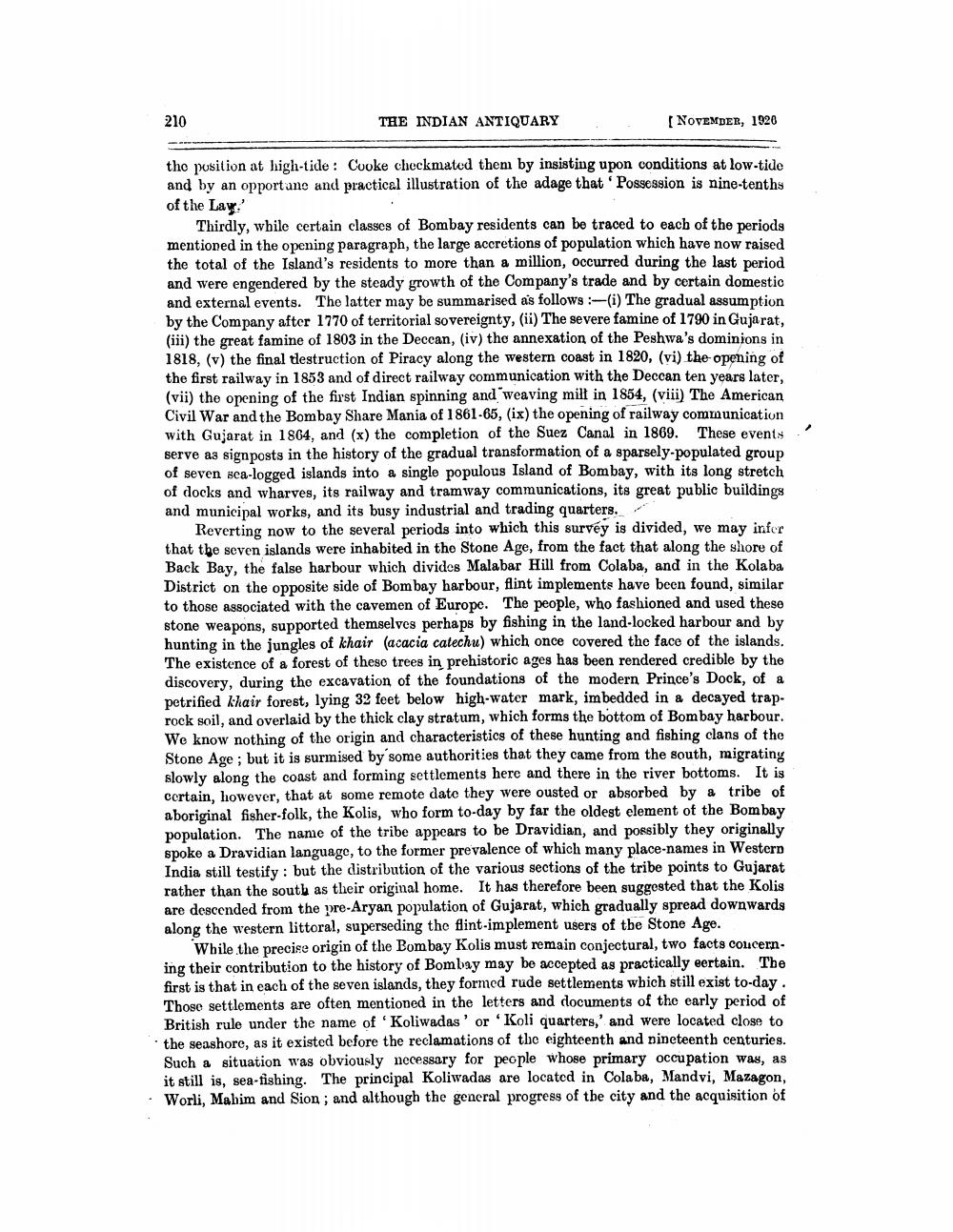________________
210
THE INDIAN ANTIQUARY
( NOVEMDER, 1926
the position at high-tide: Cooke checkmated them by insisting upon conditions at low-tide and by an opportano and practical illustration of the adage that ' Possession is nine-tenths of the Lay
Thirdly, while certain classes of Bombay residents can be traced to each of the periods mentioned in the opening paragraph, the large accretions of population which have now raised the total of the Island's residents to more than a million, occurred during the last period and were engendered by the steady growth of the Company's trade and by certain domestic and external events. The latter may be summarised as follows :-(i) The gradual assumption by the Company after 1770 of territorial sovereignty, (ii) The severe famine of 1790 in Gujarat, (iii) the great famine of 1803 in the Deccan, (iv) the annexation of the Peshwa's dominions in 1818, (v) the final tlestruction of Piracy along the western coast in 1820, (vi) the opening of the first railway in 1853 and of direct railway communication with the Deccan ten years later, (vii) the opening of the first Indian spinning and weaving milt in 1854, (viii) The American Civil War and the Bombay Share Mania of 1861-65, (ix) the opening of railway communication with Gujarat in 1864, and (x) the completion of the Suez Canal in 1869. These events. serve as signposts in the history of the gradual transformation of a sparsely-populated group of seven sca-logged islands into a single populous Island of Bombay, with its long stretch of docks and wharves, its railway and tramway communications, its great public buildings and municipal works, and its busy industrial and trading quarters.
Reverting now to the several periods into which this survey is divided, we may infer that the seven islands were inhabited in the Stone Age, from the fact that along the shore of Back Bay, the false harbour which divides Malabar Hill from Colaba, and in the Kolaba District on the opposite side of Bombay harbour, flint implements have been found, similar to those associated with the cavemen of Europe. The people, who fashioned and used these stone weapons, supported themselves perhaps by fishing in the land-locked harbour and by hunting in the jungles of khair (acacia catechu) which once covered the face of the islands. The existence of a forest of theso trees in prehistoric ages has been rendered credible by the discovery, during the excavation of the foundations of the modern Prince's Dock, of a petrified khair forest, lying 32 feet below high-water mark, imbedded in a decayed traprock soil, and overlaid by the thick clay stratum, which forms the bottom of Bombay harbour. We know nothing of the origin and characteristics of these hunting and fishing clans of the Stone Age ; but it is surmised by some authorities that they came from the south, migrating slowly along the coast and forming settlements here and there in the river bottoms. It is certain, however, that at some remote date they were ousted or absorbed by a tribe of aboriginal fisher-folk, the Kolis, who form to-day by far the oldest element of the Bombay population. The name of the tribe appears to be Dravidian, and possibly they originally spoke a Dravidian language, to the former prevalence of which many place-names in Western India still testify: but the distribution of the various sections of the tribe points to Gujarat rather than the south as their original home. It has therefore been suggosted that the Kolis are descended from the pre-Aryan population of Gujarat, which gradually spread downwards along the western littoral, superseding the flint-implement users of the Stone Age.
While the precise origin of the Bombay Kolis must remain conjectural, two facts concerning their contribution to the history of Bombay may be accepted as practically eertain. The first is that in each of the seven islands, they formed rude settlements which still exist to-day. Those settlements are often mentioned in the letters and documents of the early period of British rule under the name of Koliwadas' or 'Koli quarters,' and were located close to the seashore, as it existed before the reclamations of thc eighteenth and nineteenth centuries. Such a situation was obviously necessary for people whose primary occupation was, as
it still is, sea-fishing. The principal Koliwadas are located in Colaba, Mandvi, Mazagon, · Worli, Mahim and Sion; and although the general progress of the city and the acquisition of




